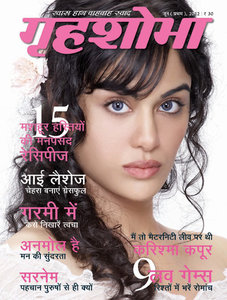
Hindi, or more precisely Modern Standard Hindi, is an Indo-Aryan language spoken chiefly in North India. Hindi has been described as a standardised and Sanskritised register of the Hindustani language, which itself is based primarily on the Khariboli dialect of Delhi and neighbouring areas of Northern India. Hindi, written in the Devanagari script, is one of the two official languages of the Government of India, along with the English language. It is an official language in 9 States and 3 Union Territories and an additional official language in 3 other States. Hindi is also one of the 22 scheduled languages of the Republic of India.

Urdu is an Indo-Aryan language spoken chiefly in South Asia. It is the official national language and lingua franca of Pakistan. In India, Urdu is an Eighth Schedule language whose status, function, and cultural heritage is recognized by the Constitution of India; it has some form of official status in several Indian states. In Nepal, Urdu is a registered regional dialect.

Hindustani is the lingua franca of Northern India and Pakistan; in linguistics and some other contexts, it is also known as Hindi–Urdu,.

Languages spoken in India belong to several language families, the major ones being the Indo-Aryan languages spoken by 78.05% of Indians and the Dravidian languages spoken by 19.64% of Indians, both families together are sometimes known as Indic languages. Languages spoken by the remaining 2.31% of the population belong to the Austroasiatic, Sino–Tibetan, Tai–Kadai and a few other minor language families and isolates. India has the world's fourth highest number of languages (447), after Nigeria (524), Indonesia (710) and Papua New Guinea (840). The Indian subcontinent is home to the third most spoken language in the world, Hindi-Urdu; the sixth most spoken language, Bengali; and the thirteenth most spoken language, Punjabi.
The Indian media consists of several different types of communications of mass media: television, radio, cinema, newspapers, magazines, and Internet-based Websites/portals. Indian media was active since the late 18th century. The print media started in India as early as 1780. Radio broadcasting began in 1927. Indian media is among the oldest in the world. It dates back even before the reign of Ashoka. Many of the media are controlled by large, for-profit corporations, which reap revenue from advertising, subscriptions, and sale of copyrighted material.

There is no national language in India. However, article 343(1) of the Indian constitution specifically mentions that, "The official language of the Union shall be Hindi in Devanagari script. The form of numerals to be used for the official purposes of the Union shall be the international form of Indian numerals." The business in Indian parliament can only be transacted in Hindi or in English. English is allowed to be used in official purposes such as parliamentary proceedings, judiciary, communications between the Central Government and a State Government. There are various official languages in India at the state/territory level. States within India have the liberty and powers to specify their own official language(s) through legislation. In addition to the official languages, the constitution recognizes 22 regional languages, which include Hindi but not English, as scheduled languages.

All India Radio (AIR), officially known since 1957 as Akashvani, is the national public radio broadcaster of India and is a division of Prasar Bharati. It was established in 1936.

Jnanpith Award is the oldest and the highest Indian literary award presented annually by the Bharatiya Jnanpith to an author for their "outstanding contribution towards literature". Instituted in 1961, the award is bestowed only on Indian writers writing in Indian languages included in the Eighth Schedule to the Constitution of India and English, with no posthumous conferral.
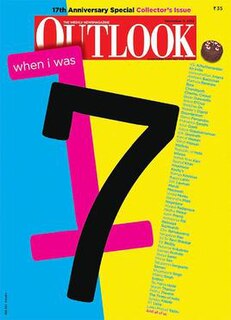
Outlook is a weekly general interest English and Hindi news magazine published in India.

Dainik Bhaskar is an Indian Hindi-language daily newspaper owned by the Dainik Bhaskar Group. According to Audit Bureau of Circulations, it is ranked 4th in the world by circulation and is the largest newspaper in India by circulation. Started in Bhopal in 1958, it expanded in 1983 with the launch of Dainik Bhaskar's Indore edition. Today, Dainik Bhaskar Group is present in 12 States with 65 editions in Hindi, Marathi and Gujarati.

The Hindi–Urdu controversy arose in 19th century colonial India out of the debate over whether the Hindi or Urdu language should be chosen as a national language.
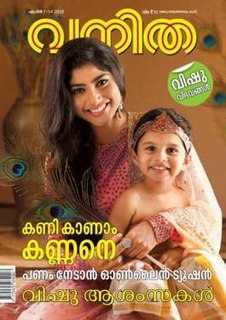
Vanitha (transl. Woman) is an Indian magazine published fortnightly by the Malayala Manorama group. It is the largest magazine in India by circulation according to Audit Bureau of Circulations, with average qualifying sales of 687,915 copies. It continues to be the largest in circulation in 2017 as well
Manushi: A Journal about Women and Society is an Indian magazine devoted to feminism as well as to gender studies and activism. The magazine was founded in 1978 by Madhu Kishwar and Ruth Vanita, two scholars based in New Delhi. It is currently published as a bi-monthly; a total of 157 issues have appeared by the end of the year 2006. Manushi is also a publishing house which prints not just works on the status of women in India but also novels and short stories with a less direct connection to gender issues.
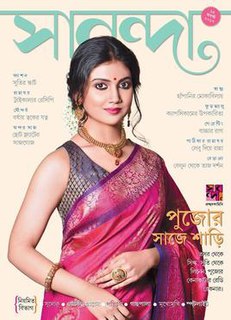
Sananda is a Bengali fortnightly women's magazine published by the ABP Group from Kolkata, India. The periodical is usually published on the 15th and 30th of every month.
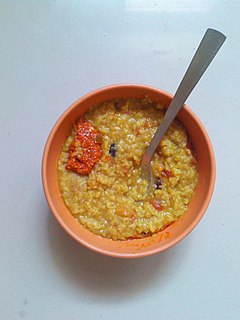
Khichdi or Khichri is a dish in South Asian cuisine made of rice and lentils (dal), but other variations include bajra and mung dal khichri. In Indian culture, in several regions, especially in the northern areas, it is considered one of the first solid foods that babies eat. Hindus, mainly from north/northwest, who avoid eating grains during fasting, eat Sabudana khichri made from sago. In the southern part of India, however, the word khichri is not that popular. While people of Tamil Nadu and Andhra regions cook Pongal, and Kannadigas prepare Bisi bele bhath, Keralites have no similar dish. Khichri is a salty porridge. Dalia is another similar sweet porridge made from the crushed wheat or barley mixed with sugar and milk.

Femina is an Indian magazine owned by Worldwide Media, a wholly owned subsidiary of the Times Group. Femina, the oldest women's English magazine in the country, has been published for almost six decades. It has evolved to cover a broad spectrum of topics, including relationships, career, fashion, beauty, and women achievers who have left a mark in their chosen field. Femina India has 2.8 million followers on Facebook, 556,600 on Instagram, and 552,000 on Twitter.
Delhi Press is one of India's largest magazine publishing houses. It publishes 36 magazines in 10 languages, and has a group readership of over 35 million. Some of its popular publications include The Caravan, Champak, Grihshobha, Saras Salil, and Sarita.
Forward Press is an English-Hindi bilingual monthly magazine covering issues relevant to India's backward classes and regions. The editor-in-chief is Ivan Kostka. Its management decided to suspend its print edition from June 2016 and convert itself to a web-only publication.

Woman's Era is an Indian fortnightly women interest magazine, published in English. It was started in 1973 by Vishwanath under his publishing house, the Delhi Press. The magazine is owned by the Delhi Press. Divesh Nath has been the managing editor of the magazine since 2002.
